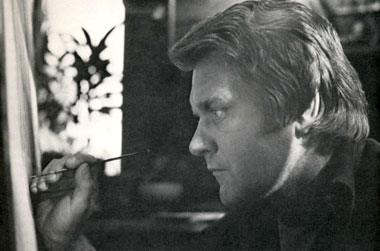Eugene Gregan: Artist's Statement
When I arrived in the Catskills in 1970, for me it was a return to nature in every way. I used to draw seeds before I planted them, and then sketched the food and the flowers as they grew. And drawing is the basis of all great painting, because it's the structure, the architecture. And when you live in nature, when you live in a place like this and study it because your survival depends on that, nature does give you what you need, everything really. And when you surrender to that , the ideas that take form are just infinite, and the forms those ideas take just get more interesting and beautiful with every new day and with every new season. So nature really is the teacher, much as we tend to forget that.
But like Cezanne — the great master chef of modern art — what I'm doing is selecting from nature what I need. Cezanne wasn't copying nature, but allowing it to give him ideas. I don't paint like him because I studied Chinese painting for 25 years. But just as Cezanne did, I also tend to get particular sensations from putting particular colors together. But every painter works differently and where Cezanne focused on structure, I tend to focus on spontenaity and on the power of the stroke. Because where you can see the actual brush mark, think of Van Gogh for example, that's the painter's energy. Which of course is why looking at paintings can feel like looking at a cardiograph; even though we aren't cardiologists, we can still tell when the patient's really alive.
In Chinese art, it's not about what the painter paints, but how, and how the energy of the artist is transferred to the field of the canvas or the paper. That's why a drawing by, say, Hokusai lives on forever; his soul is in every brush stroke and there aren't any gimics. The energy is either there and it's transferred to the field where you can see it, or it isn't. And the truth is that in a world where few people learn to draw or really even see the quality of the light, what passes as fine art in our time is often an ironic cosmic joke, quite irrespective of how it's sometimes valued.
I've been very fortunate over the years, in that I've had teachers who took an interest in me. But as a kid, even as a talented kid, I wasn't coddled or doted on. And that was fortunate because we really do have to earn our strokes and pay our dues; when things come too easily we rarely respect them. So even after a fairly high-powered teaching career of my own, I chose to become my own teacher here in these mountains, and it's worked for me. I've never wanted to be anywhere else, and the life I've designed has been filled with satisfactions great and small. Love and children , amazing food and gardens and friends and the wealth of a life rich in human exchange. It's hard to even imagine a more satisfying existence than the one I've lived , together with my wife Beverly, on this mountain. And to those of you who've been a part of it with me, I want to say thank you.
For me, this life of creativity has been all about keeping focus, about paying attention, and staying awake, aware, and conscious. What I've created , what I create every day, I'm still happy even as I grow older, to be able to share. There are works here by the thousands on canvas and paper , in wood and stone and bone and many, many works I trust, yet to take form.
What I see when I look at great painting is grace and ease, like with Monet's water lilies or Cezanne's bathers. And to stay in that place myself, what I try and do is to bring together the structure of Cezanne, the drama of Turner, and the spontaneity of the Chinese brush stroke. So my basic painting recipe is Structure, Drama, and Spontaneity. To the extent I succeed at pulling them together, it feels like it's a new form of Romanticism, a Classical Romanticism , perhaps. Actually what it is, is falling in love with nature and having the tools and the language to express that love.
So painting for me, is both a way to do that, and a form of translation. And in addition to translating that deeply romantic impulse, I also see myself as an archivist of the history of art, and of many of its techniques, ideas, and influences. For me, painting is telling what's basically a love story — more perhaps, like poetry than like a novel — and interpreting that story through the skills sharpened with a lifetime's practice. So to the extent my structures are strong enough, the light and the drama clear enough, and my gestures, free enough, then I hope I'll continue to succeed. I invite you to look around, and hope you enjoy what you see.
Warmest wishes,
Eugene Gregan
June, 2012

“To have beauty in your life, you have to focus on beauty itself.”
